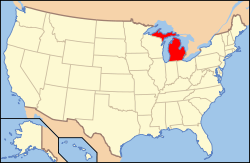Michigan Department of Corrections
| Department of Corrections | |
|---|---|
| Abbreviation | MDOC |

Patch of the Department of Corrections
|
|

Seal of the Michigan Department of Corrections
|
|
| Motto | "Committed to Protect, Dedicated to Success" |
| Agency overview | |
| Formed | 1953 |
| Preceding agency | Prison Commission |
| Employees | 14,000(2017) |
| Annual budget | $2 Billion (2010) |
| Legal personality | Governmental: Government agency |
| Jurisdictional structure | |
| Operations jurisdiction* | State of Michigan, USA |
 |
|
| Map of Department of Corrections's jurisdiction. | |
| Size | 97,990 square miles (253,800 km2) |
| Population | 10,003,422 (2008 est.) |
| General nature |
|
| Operational structure | |
| Headquarters | Lansing, Michigan |
| Agency executives |
|
| Child agencies |
|
| Website | |
| Michigan DOC Website | |
| Footnotes | |
| * Divisional agency: Division of the country, over which the agency has usual operational jurisdiction. | |
The Michigan Department of Corrections (MDOC) oversees prisons and the parole and probation population in the state of Michigan, United States. It has 31 prison facilities, and a Special Alternative Incarceration program, together composing approximately 41,000 prisoners. Another 71,000 probationers and parolees are under its supervision. (2015 figures) The agency has its headquarters in Grandview Plaza in Lansing.
The Correctional Facilities Administration (CFA) is responsible for the state's prisons and camps, including the Special Alternative Incarceration (boot camp). CFA has administrative offices in Lansing where a Deputy Director oversees the network of secure facilities. The network is divided into two regions, and each region has a Regional Prison Administrator who has oversight over wardens. At the local level, the wardens oversee daily operations of the prisons and camps. CFA also manages several peripheral aspects of facility operation, including prisoner transportation, food service and classification.
The state secure-facilities network supervises a diverse offender population. The physical plants also span centuries, from the Michigan Reformatory in Ionia (built in the late 1870s) to the modern Bellamy Creek Correctional Facility, which was completed in 2001.
As of January 2017, thirty-one DOC facilities are open and in operation.
The prisons are categorized into different security levels. A Secure Level I facility houses prisoners who are more easily managed within the network (even though they may have committed violent crimes). The state's Level V prisons house prisoners who pose maximum management problems, are a maximum security risk, or both. Some prisoners may have more than one security level.
The Field Operations Administration (FOA) is responsible for state probation and parole supervision as well as other methods of supervision, including the parole board. It also oversees the Detroit Detention Center and the Detroit Reentry Center. There are 105 field offices across the state.
The Operations Support Administration is responsible for oversight of departmental finances, personnel services - including training and recruitment of new employees, policy development, labor relations, and physical plant and environmental services.
The vision of the Michigan Offender Success Model [1] is that every offender released from prison will have the tools needed to succeed in the community and the opportunity to utilize those tools to be productive, self-sufficient citizens.
...
Wikipedia
